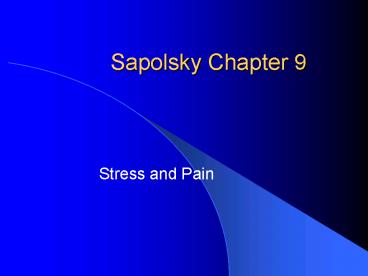Sapolsky Chapter 9 - PowerPoint PPT Presentation
1 / 25
Title:
Sapolsky Chapter 9
Description:
Cellular messengers spill out and trigger pain receptors. ... Information sent to dorsal horn of spinal cord. Glutamate Substance P = transmitters ... – PowerPoint PPT presentation
Number of Views:40
Avg rating:3.0/5.0
Title: Sapolsky Chapter 9
1
Sapolsky Chapter 9
- Stress and Pain
2
Why have pain?
- Why not a neon light on our
forehead? - Motivates, as well as informs us.
3
(No Transcript)
4
The basics of pain perception
- Cellular messengers spill out and trigger pain
receptors. - Some receptors only pain (slow, unmyelinated).
- Others paintouch (faster, myelinated).
5
(No Transcript)
6
The basics of pain perception
- Immune system cells accumulate (scarf up those
sliced-up cells) - Mast cells ? histamine ? swelling.
- Information sent to dorsal horn of spinal cord
- Glutamate Substance P transmitters
- Reflex is initiated here.
- Faster than if info had to go to cortex first.
7
(No Transcript)
8
The basics of pain perception
- Some neurons ascend on opposite side of spinal
cord to brain. - Information is sent to thalamus and several areas
of cortex. - Somatosensory cortex in parietal lobe location,
type of pain - Cingulate cortex emotional content
- Hypothalamus and other areas ? autonomic NS CRH
9
(No Transcript)
10
(No Transcript)
11
(No Transcript)
12
Modulation of pain perception
- Melzak Wall Gate theory
- Both fast slow axons excite X neuron?brain
13
Sudden pain
To brain
X
Slow pain
14
Modulation of pain perception
- Fast neuron also excites the Y interneuron,
- Which inhibits the X neuron.
- The slow pain neuron actually INHIBITS the Y
interneuron.
15
Sudden pain
-
To brain
X
Y
-
Slow pain
16
Modulation of pain perception
- Note error Sapolski says that a diabetic who
loses the fast pain fibers loses the ability to
shut down the Y interneuron. - (p. 165 in 2nd edition, p. 192 in 3rd edition)
- However, you dont want to shut down the Y
interneuronyou want to excite it!
17
Modulation of pain perception
- Descending axons from the brain to the spinal
cord, influence pain sensitivity of neuron X.
18
Sudden pain
From brain
-
To brain
X
Y
-
-
From brain
Slow pain
19
(No Transcript)
20
Modulation of pain perception
- Patients with views of trees requested less pain
medication after gall bladder surgery. - Also, sense of control helped.
- Allodynia pain in response to normal sensory
stimulus. - During migraines, after lengthy inflammation
21
Stress-induced analgesia
- Stress-induced analgesia
- Henry Beecher (WWII) 80 of civilians and 33
of soldiers requested morphine for similar
injuries. - Exercise after 30 min pain melts away and you
feel euphoria. - Animals hot plate test swim or social threat ?
stress increases time to withdraw foot.
22
Stress-induced analgesia
- Endorphins, enkephalins, dynorphins
- (Note opioids vs. opiates)
- Acupuncture (humans and animals)
- Naloxone blocks effects.
- Roger Guillemin beta-endorphin from pituitary
- One source of runners high.
- Not the only source serotonin?
- Relatively brief effect depletion of transmitters
23
Summary
- Painful stimulus activates free nerve endings,
which carry input to spinal cord via either slow,
unmyelinated fibers (slow pain) or faster,
myelinated fibers (fast pain). - The fast fibers stimulate an inhibitory Y
interneuron, which turns down pain perception. - The slow fibers inhibit the Y interneuron pain
continues!
24
Summary
- Pain input goes to brainstem, thalamus and
postcentral gyrus of parietal lobe, where it is
integrated with other somatosensory information. - Pain input also goes to anterior cingulate
cortex, frontal cortex, and hypothalamus for
emotional interpretation and response.
25
Summary
- Peaceful view, sense of control, or stress can
decrease pain intensity. - Mediated in part by opioids.
- Stress can also increase pain
- Parietal cortex still responds the same as with
no stress. - Emotion-processing areas respond more.
- Anti-anxiety drugs relieve hyperalgesia.































